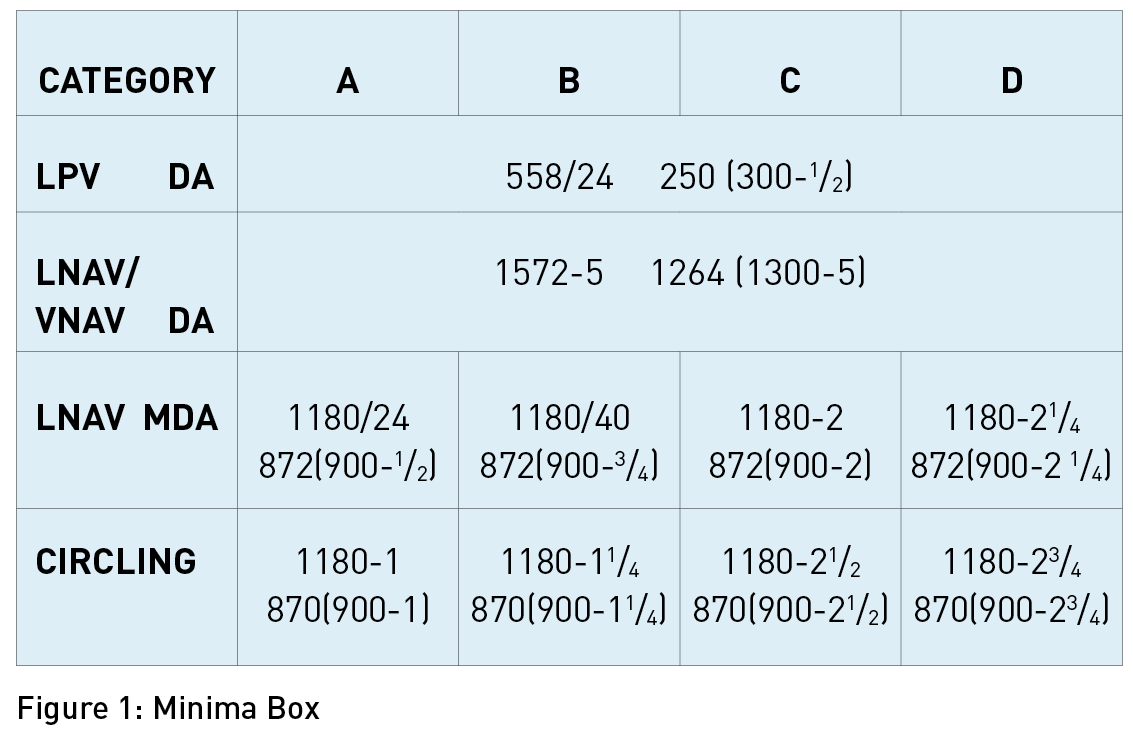
Features
Safety
Wings on safety: Busted Minimums
For many years, there were few, if any, changes to instrument approach aids.
November 3, 2010 By John Ainsworth
For many years, there were few, if any, changes to instrument approach aids. ILS actually started testing in 1929 with the first use (in Pittsburgh) in 1938. Other than MLS, which has fallen out of favour in North America and GCA/PAR which is no longer in common use, there were no new approach aids until GPS came along. Now there is a veritable alphabet soup of approach types including: LNAV, LNAV/VNAV and LPV. The common assumption is that LPV (Localizer Performance with Vertical guidance) provides greater landing utility than LNAV/VNAV (Lateral NAVigation/Vertical NAVigation) that, in turn, provides greater utility than just LNAV. In most cases, this assumption holds true but there are situations where LNAV alone provides lower minima than LNAV/VNAV and these exceptions have confused more than one pilot and led to busted minimums.

|
|
While there are very few LPV or LNAV/VNAV procedures in Canada at the present time, the new Canadian criteria based on the latest FAA criteria (8260.54A) will be released early in 2011, leading to the rapid deployment of LPV and LNAV/VNAV procedures. It is worthwhile to look at this issue south of the border so that we can hopefully avoid this problem in Canada. Figure 1, a typical minima box (from a U.S. airport), shows this anomaly. The LPV minima (Height Above Touchdown – HAT – and visibility) for Category A aircraft are 300 feet and one half mile (300-1/2), the LNAV minima are 900-1/2 while the LNAV/VNAV minima are 1300-5, higher than VFR! Further adding to the confusion, the circling minima, (900-1) are also significantly lower than the LNVA/VNAV minima.
The answer lies partly within the instrument procedure design criteria, a complex set of rules that provide a minimum clearance between the aircraft and the ground and man-made obstructions. The minimum clearance from terrain and obstructions depends on the phase of the procedure. There is no altitude guidance (other than the altimeter) at any time during an LNAV approach. On the other hand, the LNAV/VNAV approach provides vertical guidance, but only during the final approach phase prior to reaching the Decision Altitude (DA). If a missed approach is necessary at that point, there is no vertical guidance from then on.
The required clearance during the final approach phase of an LNAV/VNAV procedure is typically lower than that of the LNAV alone but the clearance for the missed approach phase is no better than that of the LNAV-only missed approach phase. Then why are the LNAV/VNAV minima in this case worse than the LNAV alone? The missed approach point for the LNAV procedure is usually at the runway threshold while the point where the aircraft reaches the DA on the LNAV/VNAV procedure is typically a mile short of the runway. There is probably an obstruction that is behind the aircraft when it is at the threshold but still in front (albeit off to one side) when the aircraft is at the DA for the LNAV/VNAV procedure. The LNAV procedure provides positive track guidance to the threshold, which takes the aircraft safely past this obstruction before the missed approach needs to be initiated. The missed approach for the LNAV/VNAV procedure, on the other hand, needs to be initiated before reaching this obstruction and, as vertical guidance is no longer available, greater clearance from the obstruction must be provided. (This has been confirmed using Final Approach instrument procedure design application.)
Why are the circling minima so much lower than the LNAV/VNAV minima? The charting rules state the circling minima can be no lower than the associated non-precision approach. As it provides vertical guidance, the LNAV/VNAV procedure is not considered a non-precision approach in the U.S., so it does not factor in the determination of circling minimums.
These two anomalies can and have caused confusion. Confusion in the cockpit, needless to say, is not a good thing. This issue has been addressed by the U.S. Aeronautical Charting Forum, a government and industry group that makes recommendations to the FAA. The group has recommended that whenever the LNAV/VNAV DA is higher than the LNAV MDA, the LNAV/VNAV procedure be published as a separate procedure with its own “plate” showing circling minima no lower than the LNAV/VNAV DA.
Until this charting issue can be resolved, all pilots should be aware of the potential for the LNAV/VNAV minima to be higher than an associated LNAV-only procedure. Hopefully, as the new criteria are rolled out in Canada, we can avoid the problem altogether.
John Ainsworth is president and CEO of Air Navigation Data, a company that provides Final Approach, a fully integrated and automated instrument procedure design application and related procedure design services for government agencies, airports, scheduled airlines and private operators.
This information is intended to increase overall safety awareness and is not a substitute for compliance with regulatory guidelines. We welcome your feedback at akwasnik@annexweb.com.